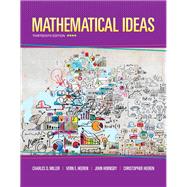Mathematical Ideas 13/e, captures the interest of non-majors who take the Liberal Arts Math course by showing how mathematics plays an important role in everyday life. With a fresh, new focus on math in the workplace, this program shows students how math will play an important role in their future, while encouraging them to understand and embrace the mathematical concepts.
Note: This is the standalone book if you want the book/access card order the ISBN below;
0321978269 / 9780321978264 Mathematical Ideas plus MyMathLab -- Access Card Package 13/e
Package consists of:
0321431308 / 9780321431301 MyMathLab -- Glue-in Access Card
0321654064 / 9780321654069 MyMathLab Inside Star Sticker
0321977076 / 9780321977076 Mathematical Ideas
NOTE: Before purchasing, check with your instructor to ensure you select the correct ISBN. Several versions of Pearson's MyLab & Mastering products exist for each title, and registrations are not transferable. To register for and use Pearson's MyLab & Mastering products, you may also need a Course ID, which your instructor will provide.
Used books, rentals, and purchases made outside of Pearson
If purchasing or renting from companies other than Pearson, the access codes for Pearson's MyLab & Mastering products may not be included, may be incorrect, or may be previously redeemed. Check with the seller before completing your purchase








